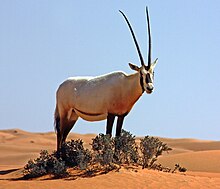Arabian Oryx
| Arabian oryx | |
|---|---|
 |
|
| An Arabian oryx in Dubai Desert Conservation Reserve, United Arab Emirates. | |
| Scientific classification | |
| Kingdom: | Animalia |
| Phylum: | Chordata |
| Clade: | Synapsida |
| Class: | Mammalia |
| Order: | Artiodactyla |
| Family: | Bovidae |
| Subfamily: | Hippotraginae |
| Genus: | Oryx |
| Species: | O. leucoryx |
| Binomial name | |
|
Oryx leucoryx Pallas, 1777 |
|
The Arabian oryx or white oryx (Oryx leucoryx) is a medium-sized antelope with a distinct shoulder bump, long, straight horns, and a tufted tail. It is a bovid, and the smallest member of the Oryx genus, native to desert and steppe areas of the Arabian Peninsula. The Arabian oryx was extinct in the wild by the early 1970s, but was saved in zoos and private preserves, and was reintroduced into the wild starting in 1980.
In 1986, the Arabian oryx was classified as endangered on the IUCN Red List, and in 2011, it was the first animal to revert to vulnerable status after previously being listed as extinct in the wild. It is listed in CITES Appendix I. In 2011, populations were estimated at over 1,000 individuals in the wild, and 6,000–7,000 individuals in captivity worldwide.
A Qatari oryx named "Orry" was chosen as the official games mascot for the 2006 Asian Games in Doha, and is shown on tailfins of planes belonging to Middle Eastern airline Qatar Airways. Arabian oryx is the national animal of UAE.
The taxonomic name Oryx leucoryx is from the Greek orux (gazelle or antelope) and leukos (white). The Arabian oryx is also called the white oryx in English, dishon in Hebrew, and is known as maha, wudhaihi, baqar al wash, and boosolah in Arabic.
Russian zoologist Peter Simon Pallas introduced "oryx" into scientific literature in 1767, applying the name to the common eland as Antilope oryx (Pallas, 1767). In 1777, he transferred the name to the Cape gemsbok. At the same time, he also described what is now called the Arabian oryx as Oryx leucoryx, giving its range as "Arabia, and perhaps Libya". In 1816, Henri Marie Ducrotay de Blainville subdivided the antelope group, adopted Oryx as a genus name, and changed the Antilope oryx of Pallas to Oryx gazella (de Blainville, 1818). In 1826, Martin Lichtenstein confused matters by transferring the name Oryx leucoryx to the scimitar-horned oryx (now Oryx dammah) which was found in the Sudan by the German naturalists Wilhelm Friedrich Hemprich and Christian Gottfried Ehrenberg (Lichtenstein, 1826). The Arabian oryx was then nameless until the first living specimens in Europe were donated to the Zoological Society of London in 1857. Not realizing this might be the Oryx leucoryx of previous authors, Dr. John Edward Gray proposed calling it Oryx beatrix after HRH the Princess Beatrice of the United Kingdom (Gray, 1857). Though this name was to persist for many years, Oldfield Thomas renamed the scimitar-horned oryx as Oryx algazal in 1903 (it has since been renamed Oryx dammah), and gave the Arabian oryx back its original name. The confusion between the two species has been exacerbated because both have been called white oryx in English.
...
Wikipedia

